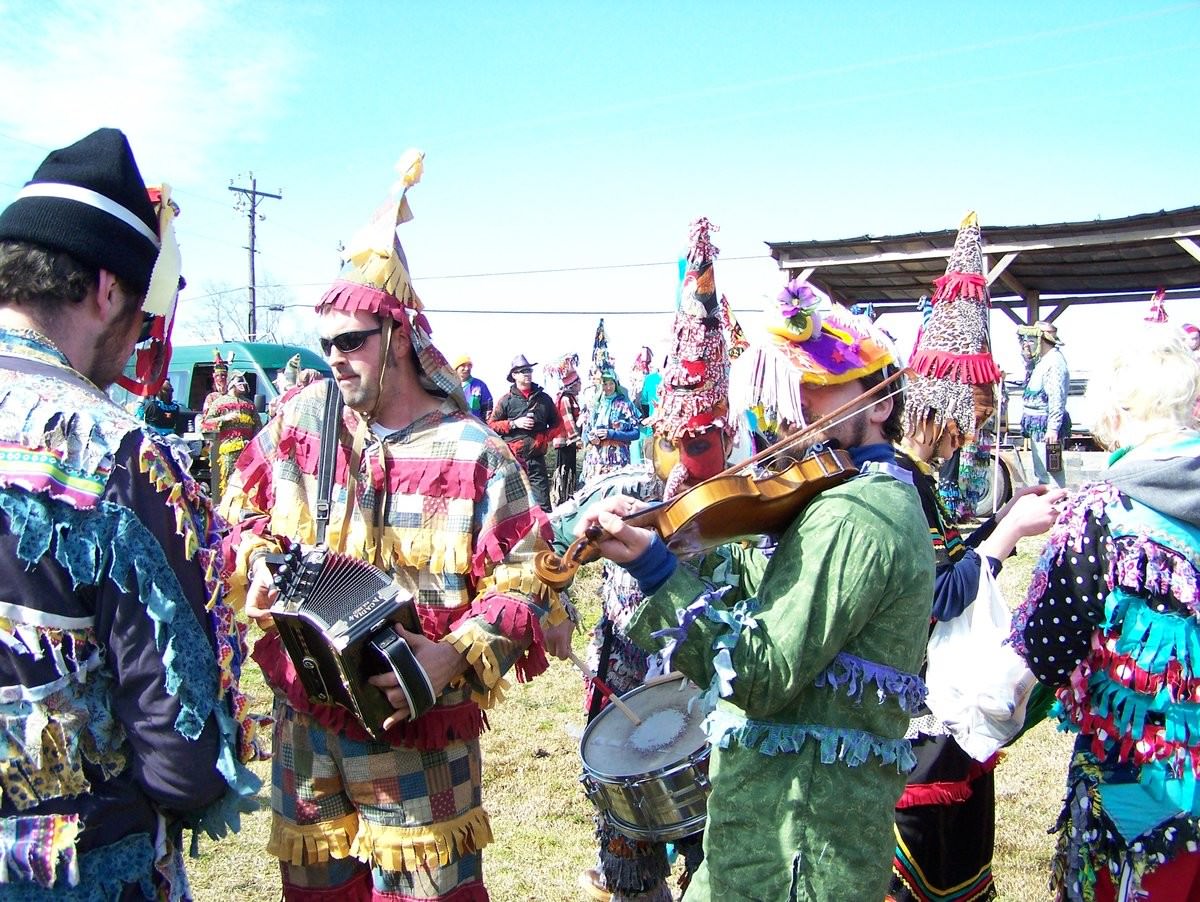Because the Mardi Gras celebration is about way more than beads and King Cake.

The traditional South Louisiana Mardi Gras includes a “run,” often on horseback, in which masked revelers in multicolored outfits go from farm to farm, house to house, begging, dancing, and singing for the ingredients to make a communal gumbo. The tradition is called Courir de Mardi Gras and also includes chasing chickens that’ll end up in the pot if they’re caught.
Modern Farmer: How important is traditional food, and gumbo in particular, to Cajun culture?
Barry Jean Ancelet: It is often said that Cajuns will plan the next meal while eating the current one. Gumbo is one of the most popular dishes for feeding a large gathering, in part because of its stretchability. The country Mardi Gras celebration in South Louisiana is based on the gathering of ingredients for a communal meal at the end of the day. Here, that meal is traditionally a gumbo made with the poultry that is gathered during the day-long run through the neighborhood.
MF: Are there regional, or generational, differences in gumbo recipes?
BJA: Gumbo recipes were typically handed down from one generation to the next. This produced regional differences in the styles of gumbo. Some areas used smoked sausages, while others preferred grilled fresh sausages, for example. Areas that were closer to the coast tended more toward seafood gumbos. Some areas preferred darker roux, while others preferred lighter ones. Some areas use only onions, while others have added celery, bell peppers, and garlic. Now, though, with improved communication and with a wider sense of community, these borders between these regional differences are becoming blurred. Now, the differences are also influenced by personal preferences.
MF: How is gumbo’s development indicative, if it is, of Cajun culture itself?
BJA: Like Cajun culture in general, gumbo is the result of a fusion of European (French and Spanish), African (mostly Senegambian) and Native American (Houma, Attakapas, etc.) influences. Originally based on browned meats and browned okra (gombo, in West Africa), it eventually came to include other browning bases, such as roux (from French tradition), in order to make the hot, soupy dish during the winter, when okra was unavailable (before electric refrigeration).
MF: Are there any Cajun folk tales in which gumbo, or other traditional foods, plays a part?
BJA: From my collection, Le trou dans le mur.
Le dernier gombo
Vieux Monsieur Leblanc était sur son lit de mort. I y restait pas beaucoup de temps, et il avait fini de faire tous ses arrangements avec sa famille. Ils avaient fait venir le prÁ¨tre pour y donner les derniers sacrements. Il avait refait son testament pour partager son bien. Il avait parlé Á sa femme et Á tous ses enfants. Il était paré pour s’en aller. D’ayoÁ¹ il était couché dans sa chambre, i pouvait entendre le monde en bas aprÁ¨s faire des préparations. Et i pouvait sentir un gombo. Il a appelé un de ses tits-enfants et i y dit, “Boy, este gombo sent Á bon.” I dit, “Va dire Á ta grandmÁ¨re que j’aimerais un tit bol pour goÁ»ter une derniÁ¨re fois.” Le garÁ§on a descendu en bas dans la cuisine. Et il a revenu tout de suite au lit de son grandpÁ¨re avec rien dans ses mains. Le vieux bougre y demande, “AyoÁ¹ mon gombo?” Le garÁ§on y dit, “Mam dit que tu peux pas en avoir. A dit que le gombo est pour aprÁ¨s l’enterrement.”
MF: (Here’s my rough translation of the story above)
The Last Gumbo
Old Mr. Leblanc was on his deathbed. He didn’t have long to live and had made all his arrangements with his family. He had called a priest to come and give him his last rites. He had made his will to disperse his property. He had spoken to his wife and all his children. He was ready to depart. As he lay in his bedroom he could hear the people down below making preparations and could smell a gumbo cooking. He called over one of his grandchildren. “Boy, that gumbo smells good. Tell your grandmother I’d like a small bowl to taste one last time.”
The boy went down to the kitchen. He came back very quickly into his grandfather’s bedroom with nothing in his hands. The old man demanded, “where’s my gumbo?” The boy responded, “Grandma says you can’t have any. She says the gumbo is for after you’re buried.”
Check out this video of folks singing and dancing for their chickens: